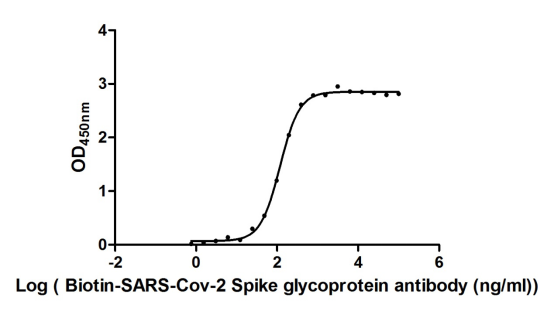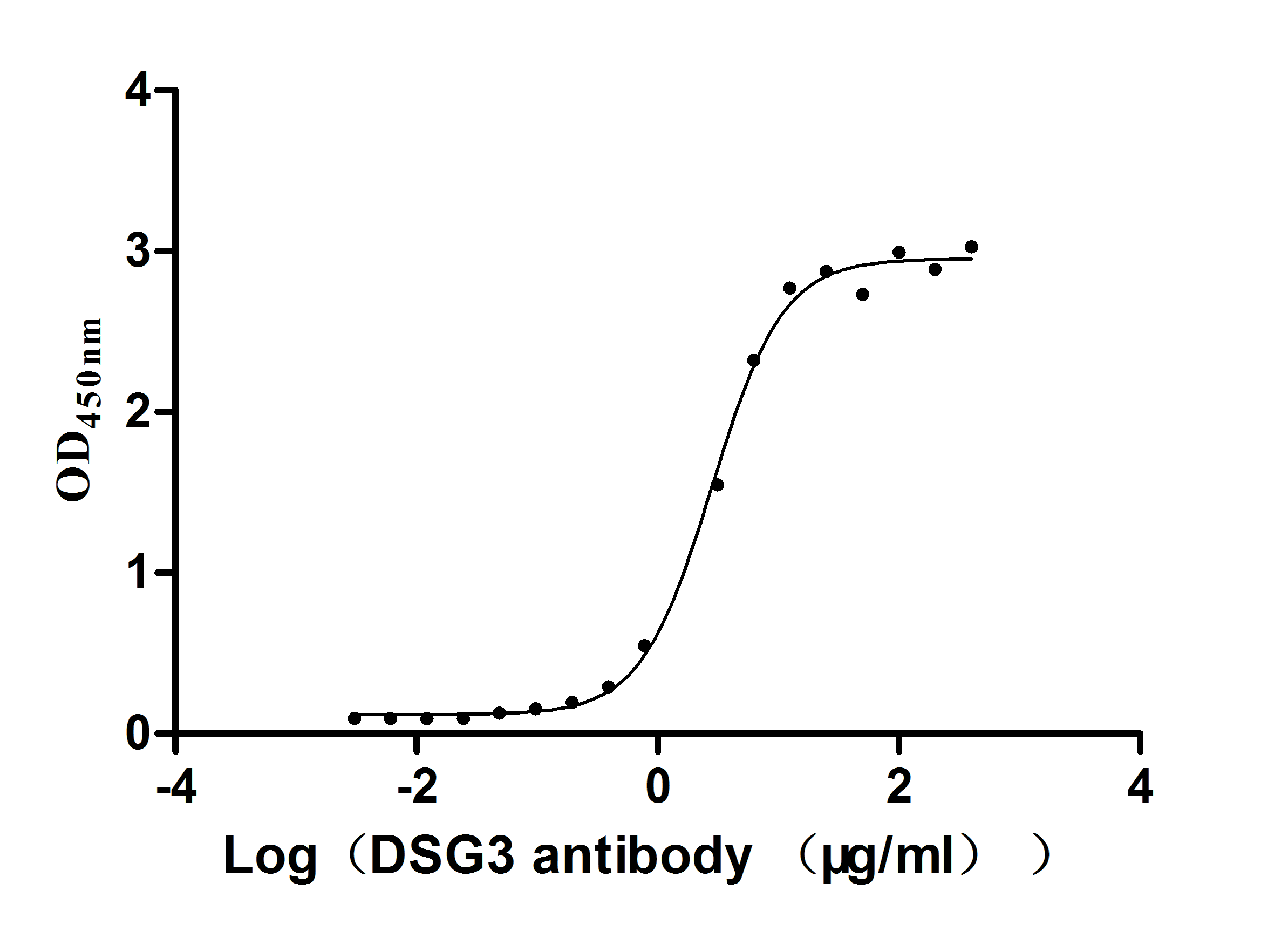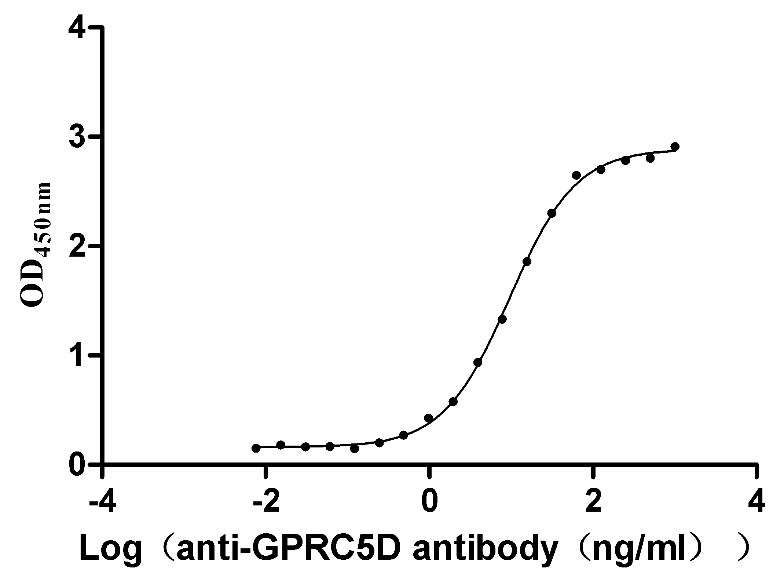Recombinant Human Protein cereblon (CRBN), partial
-
货号:CSB-YP842761HU1
-
规格:
-
来源:Yeast
-
其他:
-
货号:CSB-MP842761HU1
-
规格:
-
来源:Mammalian cell
-
其他:
产品详情
-
纯度:>85% (SDS-PAGE)
-
基因名:
-
Uniprot No.:
-
别名:CRBN; AD-006; Protein cereblon
-
种属:Homo sapiens (Human)
-
蛋白长度:Partial
-
表达区域:318-426aa
-
氨基酸序列CTSLCCKQCQETEITTKNEIFSLSLCGPMAAYVNPHGYVHETLTVYKACNLNLIGRPSTEHSWFPGYAWTVAQCKICASHIGWKFTATKKDMSPQKFWGLTRSALLPTI
-
蛋白标签:Tag type will be determined during the manufacturing process.
The tag type will be determined during production process. If you have specified tag type, please tell us and we will develop the specified tag preferentially. -
产品提供形式:Lyophilized powder
Note: We will preferentially ship the format that we have in stock, however, if you have any special requirement for the format, please remark your requirement when placing the order, we will prepare according to your demand. -
复溶:We recommend that this vial be briefly centrifuged prior to opening to bring the contents to the bottom. Please reconstitute protein in deionized sterile water to a concentration of 0.1-1.0 mg/mL.We recommend to add 5-50% of glycerol (final concentration) and aliquot for long-term storage at -20℃/-80℃. Our default final concentration of glycerol is 50%. Customers could use it as reference.
-
储存条件:Store at -20°C/-80°C upon receipt, aliquoting is necessary for mutiple use. Avoid repeated freeze-thaw cycles.
-
保质期:The shelf life is related to many factors, storage state, buffer ingredients, storage temperature and the stability of the protein itself.
Generally, the shelf life of liquid form is 6 months at -20°C/-80°C. The shelf life of lyophilized form is 12 months at -20°C/-80°C. -
货期:Delivery time may differ from different purchasing way or location, please kindly consult your local distributors for specific delivery time.Note: All of our proteins are default shipped with normal blue ice packs, if you request to ship with dry ice, please communicate with us in advance and extra fees will be charged.
-
注意事项:Repeated freezing and thawing is not recommended. Store working aliquots at 4°C for up to one week.
-
Datasheet :Please contact us to get it.
相关产品
问答及客户评论
Can you please provide the following information regarding your product Recombinant Human Protein cereblon (CRBN) CSB-MP842761HU:
Is this recombinant protein from Magnetospirillum gryphiswaldense cereblon isoform 4 with thalidomide bound to the pocket formed by three invariant tryptophan residues?
Please let me know if you have any additional questions.
Recombinant Human Protein cereblon(CRBN)
CSB-MP842761HU >> Mammalian cell
Expression Region: 1-442aa; Full length.
Tag information: Tag type will be determined during the manufacturing process.
The expected tag is C-terminal 6xHis-tagged.
Sequence:
MAGEGDQQDAAHNMGNHLPLLPAESEEEDEMEVEDQDSKEAKKPNIINFDTSLPTSHTYLGADMEEFHGRTLHDDDSCQVIPVLPQVMMILIPGQTLPLQLFHPQEVSMVRNLIQKDRTFAVLAYSNVQEREAQFGTTAEIYAYREEQDFGIEIVKVKAIGRQRFKVLELRTQSDGIQQAKVQILPECVLPSTMSAVQLESLNKCQIFPSKPVSREDQCSYKWWQKYQKRKFHCANLTSWPRWLYSLYDAETLMDRIKKQLREWDENLKDDSLPSNPIDFSYRVAACLPIDDVLRIQLLKIGSAIQRLRCELDIMNKCTSLCCKQCQETEITTKNEIFSLSLCGPMAAYVNPHGYVHETLTVYKACNLNLIGRPSTEHSWFPGYAWTVAQCKICASHIGWKFTATKKDMSPQKFWGLTRSALLPTIPDTEDEISPDKVILCL
Recombinant Human Protein cereblon(CRBN)
CSB-CF842761HU N-terminal 6xHis-tagged
CSB-CF842761HUc7 C-terminal 6xHis-tagged
CSB-CF842761HUa6 N-terminal 6xHis-B2M-tagged
Expression Region: 1-442aa; Full length.
Sequence:
MAGEGDQQDAAHNMGNHLPLLPAESEEEDEMEVEDQDSKEAKKPNIINFDTSLPTSHTYLGADMEEFHGRTLHDDDSCQVIPVLPQVMMILIPGQTLPLQLFHPQEVSMVRNLIQKDRTFAVLAYSNVQEREAQFGTTAEIYAYREEQDFGIEIVKVKAIGRQRFKVLELRTQSDGIQQAKVQILPECVLPSTMSAVQLESLNKCQIFPSKPVSREDQCSYKWWQKYQKRKFHCANLTSWPRWLYSLYDAETLMDRIKKQLREWDENLKDDSLPSNPIDFSYRVAACLPIDDVLRIQLLKIGSAIQRLRCELDIMNKCTSLCCKQCQETEITTKNEIFSLSLCGPMAAYVNPHGYVHETLTVYKACNLNLIGRPSTEHSWFPGYAWTVAQCKICASHIGWKFTATKKDMSPQKFWGLTRSALLPTIPDTEDEISPDKVILCL
The reference information of this protein: http://www.uniprot.org/uniprot/Q96SW2
What we provide is the Isoform 1, it contains the CULT Domain.The CULT domain binds thalidomide and related drugs…
But we are not sure about the binding form, we can't find related information or data. Maybe you can check more details in the above link.
Please can you provide information for all available sizes?
I am particularly anxious to know the tag for the baculovirus expressed protein. On a previous COA it is listed as N terminal 6 His tag, is this information still correct?
We would also like to know if you have received feedback from any of your customers about activity of this protein?
In addition I am looking for human DDB1 protein.
I found the following catalog number however I did not find the sequence, is this full length or partial? Have you received any feedback about activity of this protein? Do you have any other options that might be of my interest?
CSB-EP618079HU; CSB-YP618079HU; CSB-BP618079HU; CSB-MP618079HU Recombinant Human DNA damage-binding protein 1 (DDB1), partial
Please can you provide information for all available sizes of all available expression hosts?
Recombinant Human Protein cereblon(CRBN)
CSB-EP842761HU >> E.coli
You can view the full information of this product on this page.
Regarding the tag of CSB-BP842761HU, yes, the tag of the previous Lot is N-terminal 6xHis-tagged, and the tag information on the COA is surely correct.But later we have optimized a much better protein with C-terminal 9xHis-tagged, so this BP protein has been updated with C-terminal 9xHis-tagged.
If you still need the same protein as previous Lot with N-terminal 6xHis-tagged, we can also provide, please remark your requirement when placing the order.
We previously received feedback like this "I was apparently very happy with the previous order of CSB-BP842761HU, and will be placing another order soon. I would like to know if the same lead time applies to this new order? Since I recently purchase this product,I thought it may be possible that you have some of the material still made that might speed up the production time. Could you advise on the lead time of a new order?", the customer didn't feedback about the activity, but we guess it should have great potential to be active.
2.human DDB1 protein.
Recombinant Human DNA damage-binding protein 1(DDB1) ,partial
CSB-YP618079HU >> Yeast
CSB-EP618079HU >> E.coli
CSB-BP618079HU >> Baculovirus
CSB-MP618079HU >> Mammalian cell
Expression Region:391-709aa; Partial.
Tag information:EP, YP, BP, MP: Tag type will be determined during the manufacturing process.
The expected tag for each expression system is listed as follows:
YP: N-terminal 6xHis-tagged; EP, BP, MP: N-terminal 10xHis-tagged and C-terminal Myc-tagged.
Sequence:
RNGIGIHEHASIDLPGIKGLWPLRSDPNRETDDTLVLSFVGQTRVLMLNGEEVEETELMGFVDDQQTFFCGNVAHQQLIQITSASVRLVSQEPKALVSEWKEPQAKNISVASCNSSQVVVAVGRALYYLQIHPQELRQISHTEMEHEVACLDITPLGDSNGLSPLCAIGLWTDISARILKLPSFELLHKEMLGGEIIPRSILMTTFESSHYLLCALGDGALFYFGLNIETGLLSDRKKVTLGTQPTVLRTFRSLSTTNVFACSDRPTVIYSSNHKLVFSNVNLKEVNYMCPLNSDGYPDSLALANNSTLTIGTIDEIQK
靶点详情
-
功能:Substrate recognition component of a DCX (DDB1-CUL4-X-box) E3 protein ligase complex that mediates the ubiquitination and subsequent proteasomal degradation of target proteins, such as MEIS2 (Probable). Normal degradation of key regulatory proteins is required for normal limb outgrowth and expression of the fibroblast growth factor FGF8. Maintains presynaptic glutamate release and consequently cognitive functions, such as memory and learning, by negatively regulating large-conductance calcium-activated potassium (BK) channels in excitatory neurons. Likely to function by regulating the assembly and neuronal surface expression of BK channels via its interaction with KCNT1. May also be involved in regulating anxiety-like behaviors via a BK channel-independent mechanism.
-
基因功能参考文献:
- mitochondrially expressed CRBN exhibited protease activity, and was induced by oxidative stress. PMID: 27417535
- We sequenced CRBN-thalidomide binding region in 38 thalidomide embryopathy individuals and 136 Brazilians without congenital anomalies, and performed in silico analyses. Eight variants were identified, seven intronic and one in 3'UTR. PMID: 27751757
- These findings thus contribute to a growing list of ID disorders caused by CRBN mutations, broaden the spectrum of phenotypes attributable to Autosomal-recessive non-syndromic intellectual disability (ARNS-ID)and provide new insight into genotype-phenotype correlations between CRBN mutations and the aetiology of ARNS-ID. PMID: 28143899
- CRBN expression is of prognostic value in MM patients ineligible for ASCT treated with thalidomide as an immunomodulatory drug. With low expression indicating a possible suboptimal treatment outcome, measurement of CRBN expression might serve as additional prognostic tool in the personalized treatment approach. PMID: 27618360
- Plasmablast differentiation, whether induced by BAFF or CD40L, is prevented by modulation of CRBN activity with CC-220, which induces degradation of the B cell differentiation factors Aiolos and Ikaros. Downregulation of these B cell differentiation processes by CC-220 modulation of CRBN provides a new therapeutic approach to treating B cell-mediated pathology in SLE. PMID: 28848067
- High CRBN expression is associated with multiple myeloma. PMID: 28017969
- CRBN negatively regulates TLR4 signaling via attenuation of TRAF6 and TAB2 ubiquitination. PMID: 27468689
- Compared with newly diagnosed multiple myeloma, an increased prevalence of mutations in the Ras pathway genes KRAS, NRAS, and/or BRAF (72%), as well as TP53 (26%), CRBN (12%), and CRBN pathway genes (10%) was observed. PMID: 27458004
- dual assay demonstrated superior Cereblon IHC measurement in MM samples compared with the single IHC assay using a published commercial rabbit polyclonal Cereblon antibody and could be used to explore the potential utility of Cereblon as a biomarker in the clinic PMID: 26186254
- IRF4 and CRBN polymorphisms affect risk and response to treatment in multiple myeloma PMID: 28083618
- overview of the current understanding of mechanism of action of Immunomodulatory drugs via CRBN and prospects for the development of new drugs that degrade protein of interest. PMID: 27460676
- 45.2 of multiple myeloma patients were CRBN(+). Among patients treated with thalidomide-based regimens, CRBN(+) patients showed a better treatment response than did CRBN-negative patients. There was no significant difference in survival outcomes between thalidomide- and bortezomib-based regimens in CRBN(+) patients. PMID: 27365142
- GS is acetylated at lysines 11 and 14, yielding a degron that is necessary and sufficient for binding and ubiquitylation by CRL4(CRBN) and degradation by the proteasome. PMID: 26990986
- Structural dynamics of the cereblon ligand binding domain. PMID: 26024445
- Our data are consistent with the idea that the CUL4A/B-DDB1-CRBN complex catalyses the polyubiquitination and thus controls the degradation of CLC-1 channels. PMID: 26021757
- Data suggest that cereblon (CRBN) expression in peripheral blood chronic lymphocytic leukemia (CLL) cells is independent of prognostic factors and may be considered a potential biomarker. PMID: 24925210
- High levels of full-length CRBN mRNA in lower risk 5q deletion patients are necessary for the efficacy of lenalidomide. PMID: 25284710
- A copy number gain of CRBN gene might be responsible for developmental delay/intellectual disability. PMID: 25858704
- Although abnormal CRBN function may be associated with intellectual disability disease onset, its cellular mechanism is still unclear. Here, we examine the role of CRBN in aggresome formation and cytoprotection. PMID: 26188093
- Studied the protein cereblon , which has been recently indentified as a primary target of thalidomide and its C-terminal part as responsible for binding thalidomide within a domain carrying several invariant cysteine and tryptophan residues. PMID: 25569776
- The study presents the crystal structure of human CRBN bound to DDB1 and the drug lenalidomide. PMID: 25108355
- structures of the DDB1-CRBN complex bound to thalidomide, lenalidomide and pomalidomide PMID: 25043012
- CRBN expression in bone marrow myeloma cells is associated with superior treatment response to lenalidomide in refractory myeloma and thalidomide/dexamethasone in new patients. CRBN is a crucial factor for the anti-MM effect of immunomodulators. PMID: 24687382
- CRBN expression may provide a biomarker to predict response to Immunomodulatory drugs in patients with MM and its high expression can serve as a marker of good prognosis. PMID: 24118365
- CRBN and IRF4 have been shown to be associated with response to lenalidomide in patients, these findings do not translate back to HMCLs, which could be attributable to factors present in the bone marrow microenvironment. PMID: 23992230
- In the three intrinsically IMiD-resistant cell lines that clearly express detectable levels of cereblon, the absence of CRBN and DDB1 mutations suggest that potential cereblon-independent mechanisms of resistance exist PMID: 24166296
- Presents a molecular model in which drug binding to cereblon results in the interaction of Ikaros and Aiolos to CRL4(CRBN) , leading to their ubiquitination, subsequent proteasomal degradation and T cell activation. PMID: 24328678
- Data indicate that low cereblon (CRBN) expression can predict resistance to immunomodulatory drug (IMiD monotherapy and is a predictive biomarker for survival outcomes. PMID: 24129344
- Findings suggest an approach for the treatment of mental retardation associated with cereblon nonsense mutation. PMID: 23983124
- We investigated the role of CRBN in response to lenalidomide in myelodysplastic syndrome infants without chromosome 5 deletion. PMID: 23434730
- We conclude that CRBN expression may be associated with the clinical efficacy of thalidomide. PMID: 23233657
- These findings suggest that CRBN may modulate proteasome activity by directly interacting with the beta7 subunit. PMID: 23026050
- Data show that in a cereblon-dependent fashion, lenalidomide downregulates IRF4 and SPIB, transcription factors that together prevent IFNbeta production. PMID: 22698399
- CRBN is an essential requirement for immunoregulatory drugs activity and a possible biomarker for the clinical assessment of antimyeloma efficacy. PMID: 21860026
- CRBN directly interacts with the alpha1 subunit of AMP-activated protein kinase (AMPK alpha1) and inhibits the activation of AMPK activation. PMID: 21232561
- The results suggest that mutCRBN may cause ARNSID by disrupting the developmental regulation of BK(Ca) in brain regions that are critical for memory and learning. PMID: 20131966
- A nonsense mutation causing a premature stop codon in CRBN was found in a large kindred with mild mental retardation. ATP-dependent degradation of proteins may play a role in memory and learning. PMID: 15557513
- This may suggest new functions of CRBN in cell nucleolus besides its mitochondria protease activity in cytoplasm. PMID: 17380424
- Nonsense mutation (R419X) CRBN disturbs the development of adult brain BK(Ca) isoforms. These changes are predicted to result in BK(Ca) channels with a higher intracellular Ca(2+) sensitivity, faster activation, and slower deactivation kinetics. PMID: 18414909
显示更多
收起更多
-
相关疾病:Mental retardation, autosomal recessive 2A (MRT2A)
-
亚细胞定位:Cytoplasm. Nucleus. Membrane; Peripheral membrane protein.
-
蛋白家族:CRBN family
-
组织特异性:Widely expressed. Highly expressed in brain.
-
数据库链接:
HGNC: 30185
OMIM: 607417
KEGG: hsa:51185
STRING: 9606.ENSP00000231948
UniGene: Hs.18925
Most popular with customers
-
Recombinant Severe acute respiratory syndrome coronavirus 2 Spike glycoprotein (S), partial (Active)
Express system: Mammalian cell
Species: Severe acute respiratory syndrome coronavirus 2 (2019-nCoV) (SARS-CoV-2)
-
Recombinant Mouse Desmoglein-3 (Dsg3), partial (Active)
Express system: Mammalian cell
Species: Mus musculus (Mouse)
-
Recombinant Human IGF-like family receptor 1 (IGFLR1), partial (Active)
Express system: Mammalian cell
Species: Homo sapiens (Human)
-
Recombinant Human C-X-C chemokine receptor type 4 (CXCR4)-VLPs (Active)
Express system: Mammalian cell
Species: Homo sapiens (Human)
-
Recombinant Human G-protein coupled receptor family C group 5 member D (GPRC5D)-VLPs (Active)
Express system: Mammalian cell
Species: Homo sapiens (Human)
-
Recombinant Dog Angiopoietin-2 (ANGPT2) (Active)
Express system: Mammalian cell
Species: Canis lupus familiaris (Dog) (Canis familiaris)
-
Recombinant Human Trophoblast glycoprotein (TPBG), partial (Active)
Express system: Mammalian cell
Species: Homo sapiens (Human)
-
Recombinant Mouse Cytotoxic and regulatory T-cell molecule (Crtam), partial (Active)
Express system: Mammalian cell
Species: Mus musculus (Mouse)





-AC1.jpg)














